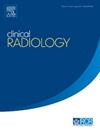Clinical effect of catheter-directed thrombolysis combined with intermittent pneumatic compression on lower extremity deep venous thrombosis
IF 2.1
3区 医学
Q2 RADIOLOGY, NUCLEAR MEDICINE & MEDICAL IMAGING
引用次数: 0
Abstract
AIM
This study investigated the effectiveness of catheter-directed thrombolysis (CDT) combined with intermittent pneumatic compression (IPC) in patients with lower extremity deep venous thrombosis (LEDVT).
Materials and Methods
A retrospective analysis was conducted on 68 LEDVT patients. Those who received CDT with IPC were assigned to the IPC group, while those who underwent CDT alone were designated as the control group. Both groups were further divided into early and late subgroups based on the time from symptom onset to CDT. Data collected included the cumulative urokinase dosage, CDT duration, and other relevant clinical indicators.
Results
The cumulative urokinase dosage was lower in the IPC group than in the control group (P<0.05). CDT duration was shorter in the IPC group than in the control group and was also shorter in the early subgroup compared with the late subgroup (all P<0.05). The peak D-dimer occurred earlier in the IPC group than in the control group (P<0.05). The incidence of grade II–III thrombolysis was higher in the IPC group than in the control group on days 2 and 3 of CDT (all P<0.05). The IPC group showed a greater reduction in thigh and calf circumference than the control group on days 3 and 4 of CDT (all P<0.05).
Conclusions
In LEDVT patients, CDT combined with IPC reduced the cumulative urokinase dosage, shortened CDT duration, promoted earlier deep vein patency, and accelerated the relief of lower extremity swelling.
导管溶栓联合间歇气压加压治疗下肢深静脉血栓的临床效果
目的探讨导管溶栓(CDT)联合间歇气压加压(IPC)治疗下肢深静脉血栓形成(LEDVT)的疗效。材料与方法对68例LEDVT患者进行回顾性分析。接受CDT合并IPC的患者被指定为IPC组,而单独接受CDT的患者被指定为对照组。根据症状出现到CDT的时间,两组进一步分为早期和晚期亚组。收集的数据包括尿激酶累积剂量、CDT持续时间及其他相关临床指标。结果IPC组尿激酶累积剂量低于对照组(p < 0.05)。IPC组CDT持续时间短于对照组,早期亚组CDT持续时间也短于晚期亚组(p < 0.05)。IPC组d -二聚体峰值出现时间早于对照组(P<0.05)。CDT治疗第2、3天IPC组II-III级溶栓发生率高于对照组(p < 0.05)。在CDT的第3天和第4天,IPC组的大腿和小腿围比对照组减少更多(p < 0.05)。结论CDT联合IPC可降低LEDVT患者尿激酶累积剂量,缩短CDT持续时间,促进深静脉早期通畅,加速下肢肿胀缓解。
本文章由计算机程序翻译,如有差异,请以英文原文为准。
求助全文
约1分钟内获得全文
求助全文
来源期刊

Clinical radiology
医学-核医学
CiteScore
4.70
自引率
3.80%
发文量
528
审稿时长
76 days
期刊介绍:
Clinical Radiology is published by Elsevier on behalf of The Royal College of Radiologists. Clinical Radiology is an International Journal bringing you original research, editorials and review articles on all aspects of diagnostic imaging, including:
• Computed tomography
• Magnetic resonance imaging
• Ultrasonography
• Digital radiology
• Interventional radiology
• Radiography
• Nuclear medicine
Papers on radiological protection, quality assurance, audit in radiology and matters relating to radiological training and education are also included. In addition, each issue contains correspondence, book reviews and notices of forthcoming events.
 求助内容:
求助内容: 应助结果提醒方式:
应助结果提醒方式:


